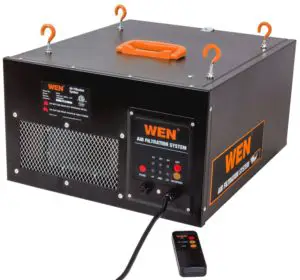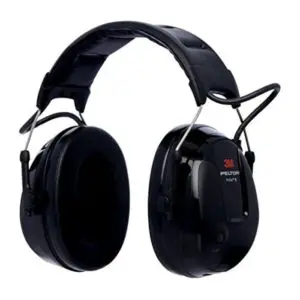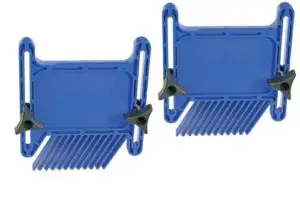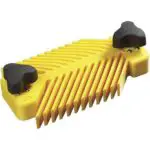It goes without saying that woodworking can be a dangerous hobby or career if the proper steps aren’t taken to protect yourself. Many people think automatically assume woodworking safety is limited to protecting your fingers and hands from saw blades. It goes much further. Woodworking requires safety measures be put in place due to long term exposures to both air quality and loud noises.
Below I will cover four important, but often overlooked safety features that all woodworkers should have for their shop. This list is certainly not all encompassing, as there are many more safety tools and accessories that should be considered depending on your setup. The great thing about the list below, all four items can be purchased for less than $225.
Dust collection
Dust collection is probably the most overlooked danger present in a woodworker’s shop. Many people believe having and using a shop vac is enough to protect their lungs from long term damage. This is far from the truth. The concern goes far beyond the sawdust that is visible. The greater concern is the tiny particles flying around that you can’t see. To see an in depth look at the dangers of woodworking dusts, you can see my article here.
 Fortunately, there are affordable options available for everyone from professional woodworkers to those who only do it on the weekends. I picked up the WEN 3410 from Amazon (Link Here). I think this is an excellent choice for anyone who has a tight budget. I was skeptical when I first purchased it due to the low price compared to some of the other brands on the market. This particular unit can be found for about $125 which is less than half the price of some of the other units available.
Fortunately, there are affordable options available for everyone from professional woodworkers to those who only do it on the weekends. I picked up the WEN 3410 from Amazon (Link Here). I think this is an excellent choice for anyone who has a tight budget. I was skeptical when I first purchased it due to the low price compared to some of the other brands on the market. This particular unit can be found for about $125 which is less than half the price of some of the other units available.
I recently wrote a detailed review on this particular model. I’ve had the unit for a bit over a year and been super impressed with it. Here’s a link to my larger review.
Hearing Protection
Studies have shown that long term exposure to loud noises such as saws and other tools used in a wood shop can cause hearing damage. For a more in depth article on the importance of protecting your ears, check out another article I wrote , here.
 Now days, there are numerous options available on the market that will protect you ears. Personally, I have a few different pairs of ear muffs scattered throughout my shop that I’ve accumulated over the years. I try to have a pair within a few steps of each of my main saws. I have two pairs that I recommend. If your on a tight budget, I’d suggest picking up the ClearArmor 14100 for a nice budget set of ear muffs. Per the manufacturer, these ear muffs reduce noises by approximately 31 decibels which is great for a shop.
Now days, there are numerous options available on the market that will protect you ears. Personally, I have a few different pairs of ear muffs scattered throughout my shop that I’ve accumulated over the years. I try to have a pair within a few steps of each of my main saws. I have two pairs that I recommend. If your on a tight budget, I’d suggest picking up the ClearArmor 14100 for a nice budget set of ear muffs. Per the manufacturer, these ear muffs reduce noises by approximately 31 decibels which is great for a shop.
The other more expensive option that I recommend is the 3M Peltor Protac III’s. You notice this model is much slimmer that the ones made by ClearArmor, therefore they are lighter. These reduce noise by approximately 21 decibels, which is less than the other model. I tend to use these ear muffs when I’m going to be wearing them for longer periods of time, and the noises are going to be in quick, short bursts such as when I’m using a mitre saw or joiner.
Eye Protection
Over the years, I’ve used several types of eye glasses and goggles. I usually end up having 2 issues – I can’t find a pair when I need them and if I do find them, they fog up or attract dust that cause me to have to constantly wipe them. A couple years ago, I decided to try this pair of Dewalt goggles. I was a bit skeptical, due to the price point, but I was pleasantly surprised. These goggles have been excellent. Given their price, I’ve bought several pairs and leave scattered throughout my shop so I can (usually) find a pair very quickly. I’ve also had no issues with them fogging up or getting too dirty. I highly recommend picking up a pair.
Feather boards
Feather boards are the most often overlooked safety devices in woodworking. I try to use one as often as I can because they do offer protection but they also help ensure I get consistent cuts.
A feather board can be used on a number of different machines including a table saw, router table, band saw and joiner. One of the benefits to using them is that they push against the side of the board you are cutting to ensure it stays flat against the fence on your saw. This is crucial in order to get perfectly straight cuts.
The more important feature of feather boards is that they help prevent kickbacks. Kickbacks occur when a board pinches a rotating blade and ejects the wood back towards the operator. This is very common when using table saws because the blade spinning towards the operator as he/she is pushing the wood into the blade. A kickback can occur in a fraction of a second is actually one of the leading causes of serious injuries when operating a table saw.
A feather board works by reducing the risk of the board moving backwards towards the saw operator. It does this by using the bristle looking pieces (feathers) as a lock that forces the wood to only go in one direction.
There are multiple brands of feature boards on the market. There are two that I recommend. The first is the Kreg True-Flex that comes as a two pack. The boards lock to your saw using the guide slots that are on the table.
The other feather board I recommend is a bit more expensive, but it’s a bit quicker to setup because instead of having to place the feather boards into the slots on the saw and tightening them down, these do so by using a magnet. This makes them much faster. This one made by Magswitch is very high quality and has a bunch of positive reviews.


